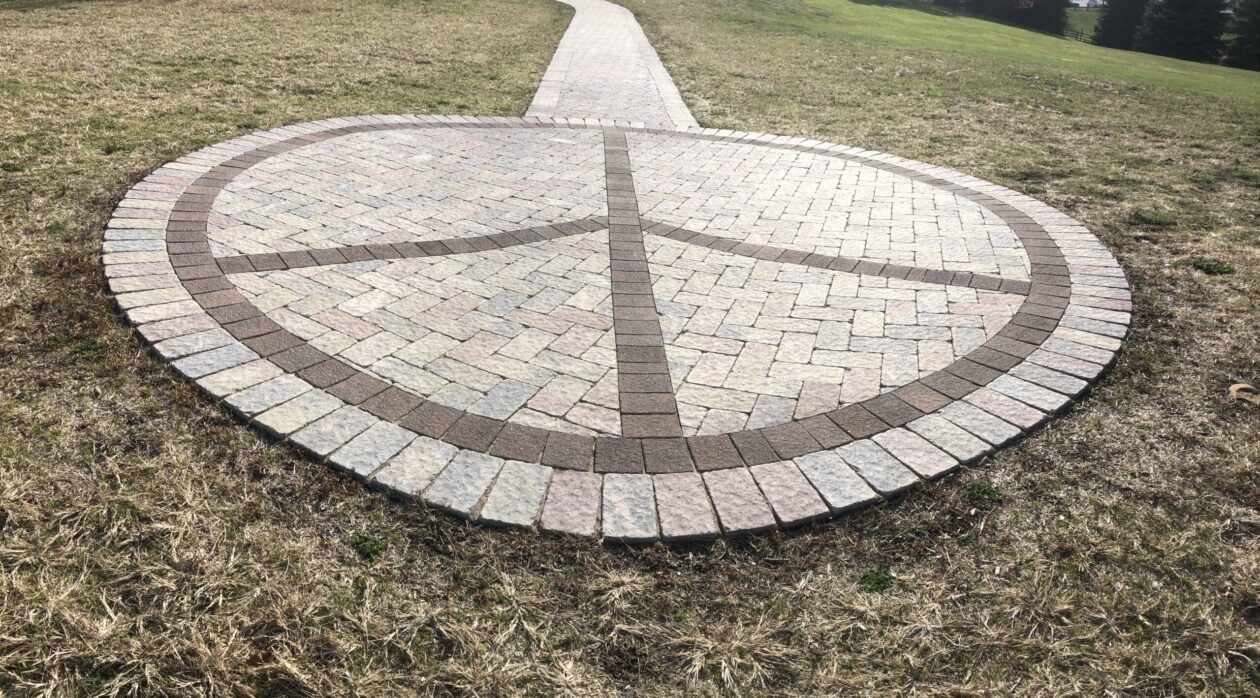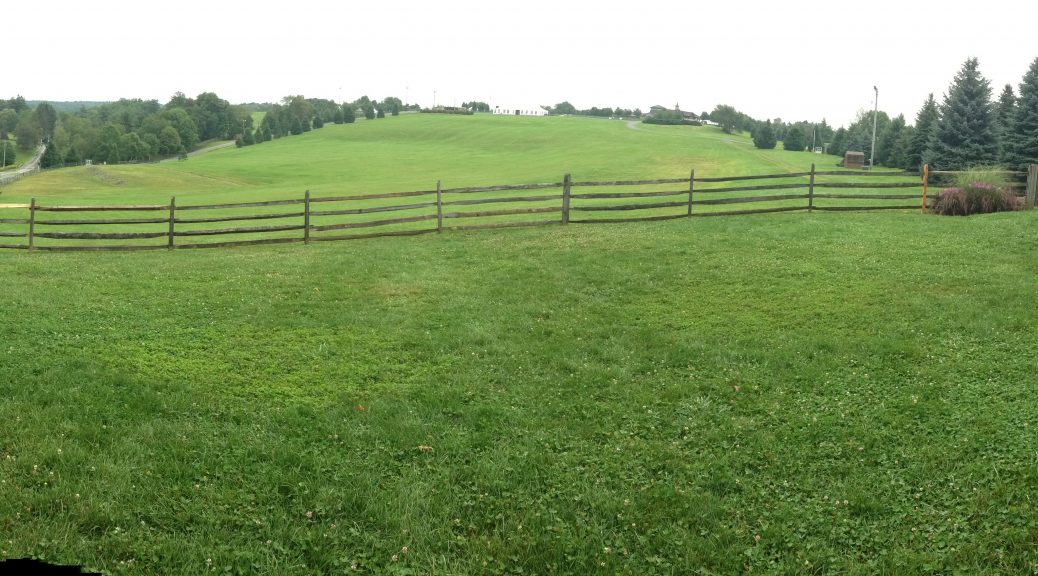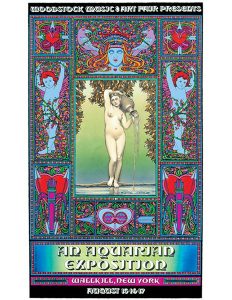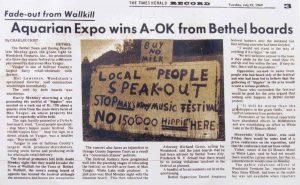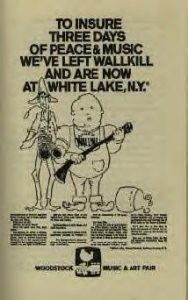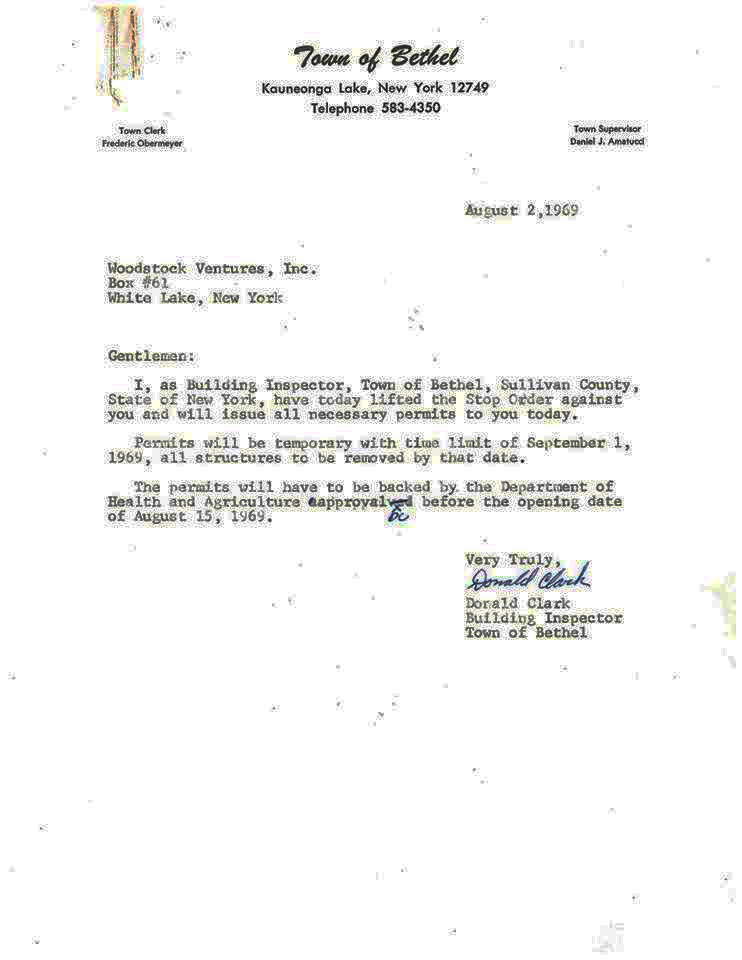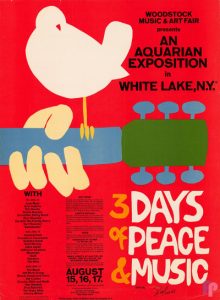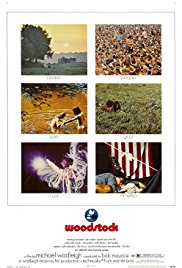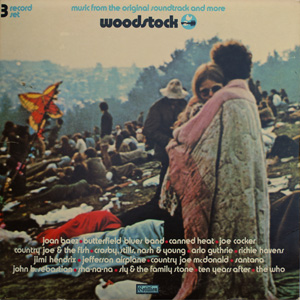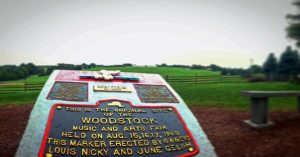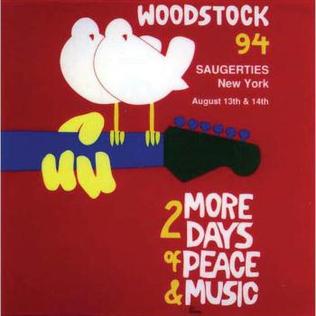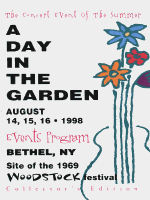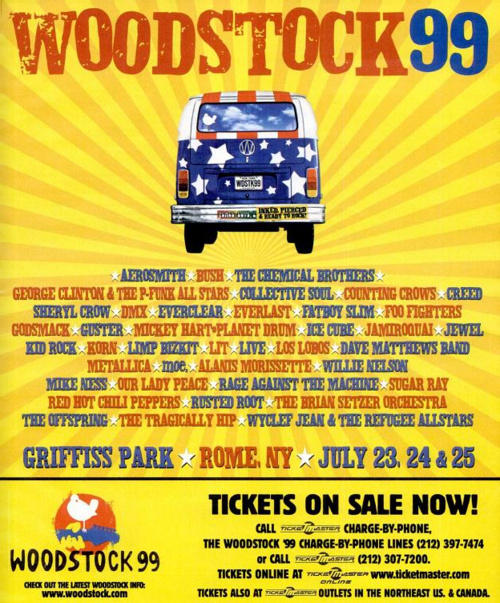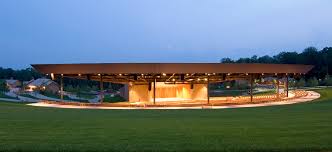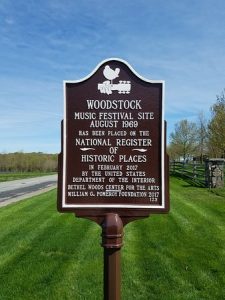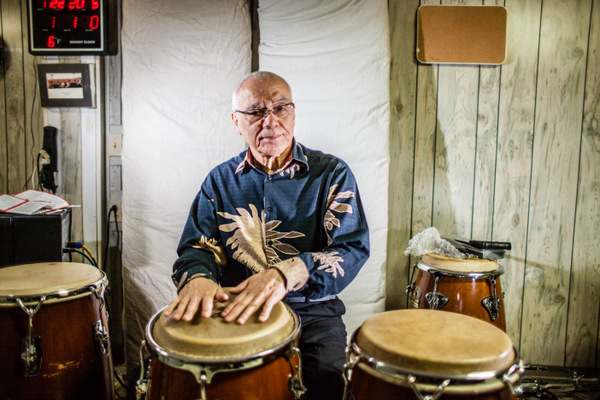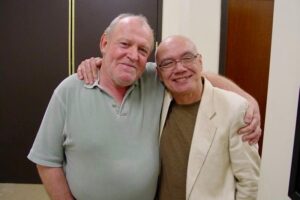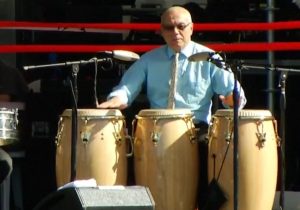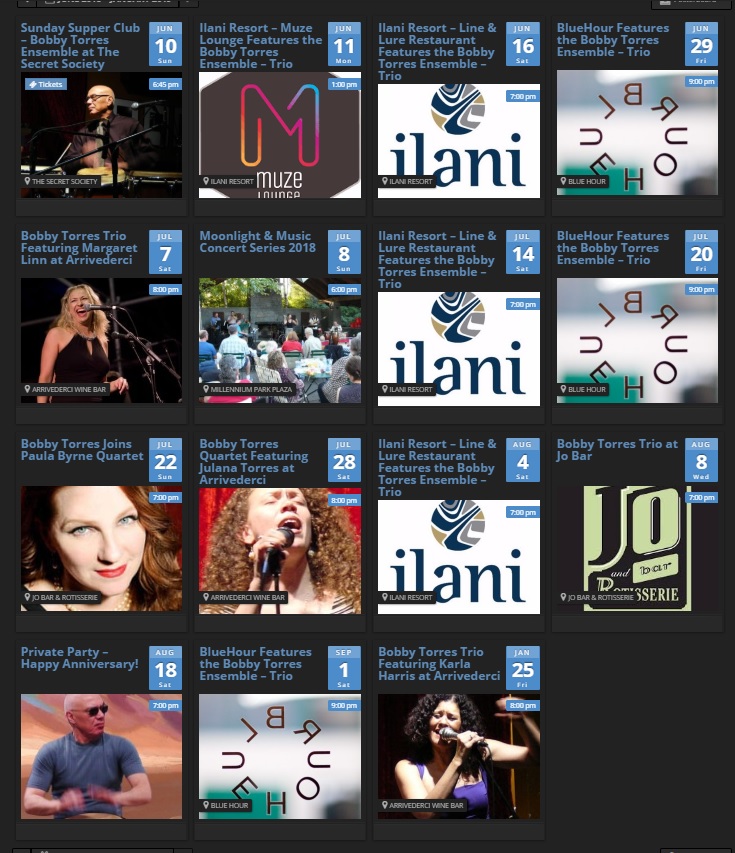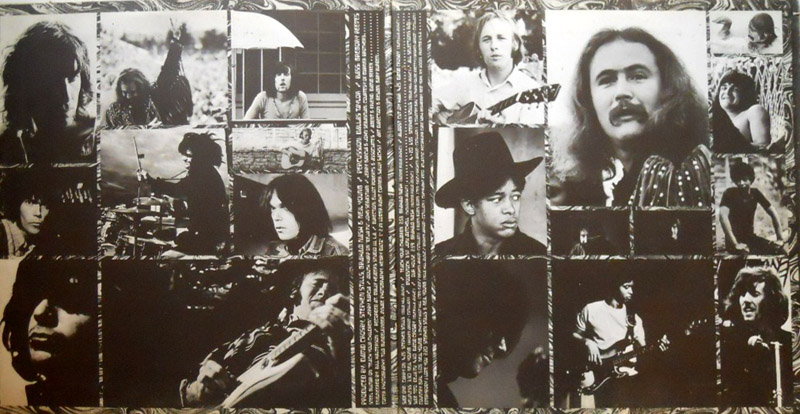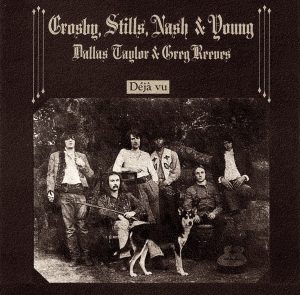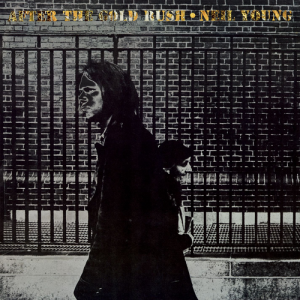Chronology Woodstock Music Art Fair
Disclaimer
No one, not even Woodstock Ventures, knew that the Woodstock Music and Art Fair would turn out to be the historic event it did.
There was no amanuensis recording each word spoken, filing every letter and news article, or simply describing every scene during the festival’s bumpy road to Bethel, NY.
Anyone’s memory of the event, whether of the preceding months’ hectic preparations or the festival’s four long hectic days and nights in August, or the decades following must be taken with a milligram (or two) of whatever substance one uses to keep memory in perspective.
Also, some amounts are given for what Woodstock Ventures paid a band. While these numbers were found in “official” sources (well-researched books), one must again keep in mind that such numbers may not be reliable.
Chronology Woodstock Music Art Fair
Woodstock before Woodstock
from The Road to Woodstock, by Michael Lang
In 1903: “In 1903 a trio of utopians—wealthy Englishman Ralph White-head, writer Hervey White, and artist Bolton Brown—settled in Woodstock to pursue philosopher Jun Ruskin’s stance against rampant industrialization. On 1,200 acres…they created the Byrdcliffe Arts Colony to pursue the ideas of the arts-and-crafts movement.
In 1912: “a branch of New York City’s Art Students League set up a summer program [in Woodstock, NY], and some painters and sculptors stayed on in town.”
August 24, 1915: the first annual Maverick Festival. A flyer promised “wild sports going on” and the dancer Lada, who “illumes beautiful music like poems, and makes you feel its religion…you cry, it is so exquisite to see….All this in the wild stone-quarry theatre, in the moonlight, with the orchestra wailing in rapture, and the jealous torches flaring int eh wind! In the afternoon, there is also a concert, with a pageant, and strange doings on the stage….There will be a village that will stand but for a day, which mad artists have hung with glorious banners and blazoned in the entrance through the woods.”
In 1920s: (from The Road to Woodstock, by Michael Lang) in Woodstock, NY, “there were bacchanalian fetes, with eccentric celebrants wearing handmade costumes for all-night revelry.”
Chronology Woodstock Music Art Fair
Roberts, Rosenman, Lang, & Kornfeld
May 1966: John Roberts graduated from the University of Pennsylvania.and through a Penn friend, meets Joel Rosenman.
March 22, 1967: John Roberts and business partner Joel Rosenman are roommates in NYC. They form Challenge International, Ltd. and place advert in the NYT and Wall St Journal: They are…”Young men with unlimited capital looking for interesting, legitimate investment opportunities and business propositions.”
June 13, 1967: a local TV news special in Miami aired “Marijuana in Miami.” The special included Michael Lang’s head shop.
Late summer 1968: Michael Lang moved to Woodstock, NY.
September 1968: Michael and Artie Kornfeld began to look for a site for a festival. Apparently, they’d already come up with the idea of a recording studio in Woodstock.
I have never been able to determine with any certainty whether Lang, living in Woodstock, or Kornfeld, with many recording connections, knew about Albert Grossman’s plan to build a recording studio in Bearsville, NY, in the town of Woodstock. Bearsville Studio.
Bearsville’s first recording studio, Studio B, was completed in 1969.
Chronology Woodstock Music Art Fair
Germination/1969
February 6, 1969: Michael Lang and Artie Kornfeld met John Roberts and Joel Rosenman for the first time. Lang and Kornfeld propose a music studio retreat in Woodstock, NY that would be an ideal place for musicians to make music in a relaxed atmosphere in an area where many other young musicians live.
February 10: Michael Lang and Artie Kornfeld met with John Roberts and Joel Rosenman a second time. They discussed the idea of a concert to promote the proposed recording studio.
Chronology Woodstock Music Art Fair
The first W: Woodstock (Ventures)
February 28: Joel Rosenman, John Roberts, and Michael Lang signed the contract creating Woodstock Ventures and its plan for
1) a recording studio in Woodstock, NY and
2) a festival in Saugerties, NY.
Artie Kornfeld could not sign the contract because he was still under contract with with Capitol Records. Michael Lang agreed to hold Kornfeld’s share until the Capitol contract expired.
March 29: Lang had found a suitable site in Saugerties, NY right off the NY Thruway. John Roberts and Joel Rosenman met with a Mr Holmes, the lawyer for Mr Shaler, the site’s owner. Holmes emphatically told Roberts and Rosenman that the site was not for rent for such a purpose.
The Saugerties site’s lack of rustic feel Lang had hoped to have disappointed him anyway.
March 18, 1969: John Roberts tells his father, Alfred, about the concert plans. Alfred is very skeptical.
Chronology Woodstock Music Art Fair
The second W: Wallkill
Howard Mills
That disappointment became moot when on March 30, after the Saugerties refusal, Roberts and Rosenman spoke to Howard Mills about a piece of land in Wallkill, NY that Mills was going to develop. Mills agreed to rent the site for the festival.
Somewhere else
In April 1969: Allan Mann met with Elliot Tibor who offered a barn for a theater from free if Mann would rent a nearby 6-room Victorian for the summer for $800. Paul Johnson, a friend of Mann, agreed to put the down payment of $200 for the house in exchange for a room there for the summer–keep in mind, this agreement predates the Wallkill eviction.
Chronology Woodstock Music Art Fair
Personnel choices
April 12: Mel Lawrence and Tom Rounds arrived in NY. They had organized rock concerts in Hawaii, the Fantasy Fair, and had organized Miami Pop in 1968.
April 13: Mel Lawrence, Tom Rounds, Tom Driscoll, Bill Hanley, Stanley Goldstein, and Michael Lang visited the Wallkill site. Mel Lawrence became the festival’s Chief-of-Operations.
Chronology Woodstock Music Art Fair
Mid-April
- Creedence Clearwater Revival first act signed to perform. $10,000.
- Michael Lang and Joel Rosenman co-sign a $10,000 check to construct offices for Woodstock Ventures at 47 W 57th Street in NYC. Bert Cohan in charge. They also put down $4,500 as a deposit on a property in Woodstock for the recording studio (the Tapooz property).
- a $14,000 check given to Alexander Tapooz for deposit on Woodstock retreat studio.
Chronology Woodstock Music Art Fair
Well underway
- April 18: the Wallkill Zoning Board of Appeals gave permission for the festival.
- April 18: Tim Hardin signed to perform ($2,000.)
- April 21: Canned Heat signed ($13,000)
- Week of April 28: Johnny Winter signed ($7,500); Janis Joplin signed ($15,000); and Jefferson Airplane signed ($15,000).
Chronology Woodstock Music Art Fair
May arrives
In May: Hugh Romney and the Hog Farm commune hired to work at festival for security, free food, and free stage.
May 6: Wes Pomeroy met Stanley Goldstein about concert security. Pomeroy agreed to look at site and discuss plans.
Mid-May: Roberts, Rosenman, Kornfeld, and Lang visit the Woodstock Ventures offices. Roberts and Rosenman have never seen such a layout. Kornfeld and Lang are happy with its laid back set-up.
May 20: Michael Lang found separate office space at 513-A Avenue of the Americas in NYC so he could be away from the other organizers.
May 21: The Band signed.
May 27: Press release: the production staff for the festival was completed. Wartoke Concern is the festival’s public relations firm. [Wartoke’s press release re festival]
May 28: Mel Lawrence presented first “checklist” for the festival’s execution.
Incredible String Band and Ravi Shankar signed. $4,500 each.
Late May: newspapers began to display the first print advertisements for the festival.
Chronology Woodstock Music Art Fair
Woodstock Venture Adventures
June 2: just after midnight Michael Lang arrived very late for a meeting with John Roberts and Joel Rosenman. Roberts and Rosenman were upset with Lang’s lack of communication and his unfettered methods of organizing the festival. They are also upset with press releases never listing their names as primaries involved.
Lang convinced Roberts and Rosenman that it was Artie Kornfeld they should upset with.
That afternoon Joel Rosenman confronted Kornfeld with Lang’s complaints. Kornfeld stated that Lang told him that Rosenman and Roberts were the problems.
Even later that afternoon all four met. Roberts, Rosenman, and Kornfeld tried to confront Lang. Lang convinced the others that all was best if they all worked together toward the goal.
June 3: Michael Lang met Wes Pomeroy to discuss Pomeroy’s attitude toward security. Pomeroy explained that the attendees must feel that there is no threat from security. Lang agreed.
~June 6, 7, or 8: Sweetwater and Blood, Sweat and Tears ($15,000) signed for festival.
Chronology Woodstock Music Art Fair
Wallkill blow-back begins
June 7: after the festival site received many threatening calls, Mel Lawrence called workers together to warn them about behavior, particularly drug use, as there might be a narcotic agent planted in the group.
June 9: an unnamed official visits the site and said that the group did not have permission for the festival.
June 11: in an attempt to counterbalance negative local feelings about festival, Stanley Goldstein, lawyer for Woodstock Ventures, contacted the Times Herald Record and provided information about festival.
June 12: Stanley Goldstein and Don Ganoung (minister and head of community relations) attended public meeting in Wallkill Town Hall in an attempt to allay antagonism toward festival. Town Supervisor, Jack Schlosser was against the event, but attempted to provide a fair hearing.
June 13, 1968: the Earth Light Theatre began performances in the converted barn on Elliot Tibor’s El Monaco property.
June 14: John Roberts and Joel Rosenman received a certified letter from Wallkill Town Attorney Joseph Owen requesting submission of fourteen divisions of production plans.
June 14 or 15: Abbie Hoffman called Michael Lang saying that he (Hoffman) needed money from Woodstock Ventures or else he (Hoffman) will shut down the festival.
June 15:
- local residents Cliff Reynolds and Brent Rismiller (also State police) hired Jules Minker (a local lawyer who worked in NYC) to bring an injunction against festival.
- Wes Pomeroy arrived in Wallkill. Late that night Pomeroy heard about the threats Howard Mills and his family had anonymously received. Set up security around Mills’ house.
June 16: just after midnight a meeting was held about festival security. Pomeroy insisted on a “soft” approach: the Peace Service Corps.
June 16: Woodstock Ventures issued a statement to the press defending its position in the town.
June 18: Samuel W Eager, a Middletown lawyer who had agreed to represent Woodstock Ventures (WV thinking a local lawyer would be better received than a NYC one), called Jack Scholsser (Wallkill Town Supervisor) and requested an informal meeting between the members of the town board and the four Woodstock officers. It was set for June 19.
Chronology Woodstock Music Art Fair
Outside adventures
June 19: Michael Lang, Artie Kornfeld, and Joel Rosenman met with Abbie Hoffman. Hoffman demanded $50,000. They agree to $10,000.
June 19: Stanley Goldstein was served with a summons ordering the festival’s principals to appear before the State Supreme court in Goshen, NY on July 7.
June 20 – 22: Newport ‘69 Festival held Northridge, CA. On Sunday at the festival (which attracted approximately 60,000 paid admissions) police attempted to break up a small group who had tried to rush the gates. Thousands of sympathizers started throwing bottles and rocks at the police. 165 arrested. 45 charged with assaulting an officer. 90 arrested for drug-related offenses. 402 injuries.
The Times Herald Record reported the incident as a “battle” and referred to alleged charges of “attempted murder and assault with a deadly weapon.”
June 21: Stanley Goldstein met with Hugh Romney and the Hog Farm in New Mexico to discuss the Hog Farm’s role in the festival. Jim Grant, a friend and fellow law enforcement official of Wes Pomeroy accompanied Goldstein.
June 23: Jim Grant sent at letter stating that “the entire affair [the Hog Farm] appeared to be completely without organization or management.”
June 26: Woodstock Ventures held a media meeting at the Village Gate on Bleeker Street to cooperatively present, discuss, and formulate “ground rules for outdoor peace and music programs.” In the end it was agreed that the festival was to emphasize music and not politics.
June 26: the Wallkill town attorney presented Woodstock Ventures with a document outlining proposed ordinances regarding assemblies of 5,000 people or more. Such proposals as not allowing light, sound, or odor to seep beyond the festival’s specific boundaries
Such restrictions created seemingly insurmountable barriers to the event. An application for the event covering all the details had to be presented to the town no later than July 2.
June 27: The Times-Herald editorial read in part, “We regard the proposed ordinance as an example of flagrant misuse of government power….It is, in our opinion, highly improper to prohibit one event in the guise of regulating it.”
June 29: Pomeroy met with the Tri-County Citizen Band Radio Club and they agreed to assist with the Festival. (see last week of June)
Last week of June: John Fabri spoke with NYC Chief Inspector George P McManus and McManus promised cooperation with getting NYC police officers to work at the festival.
Chronology Woodstock Music Art Fair
Hot July arrives
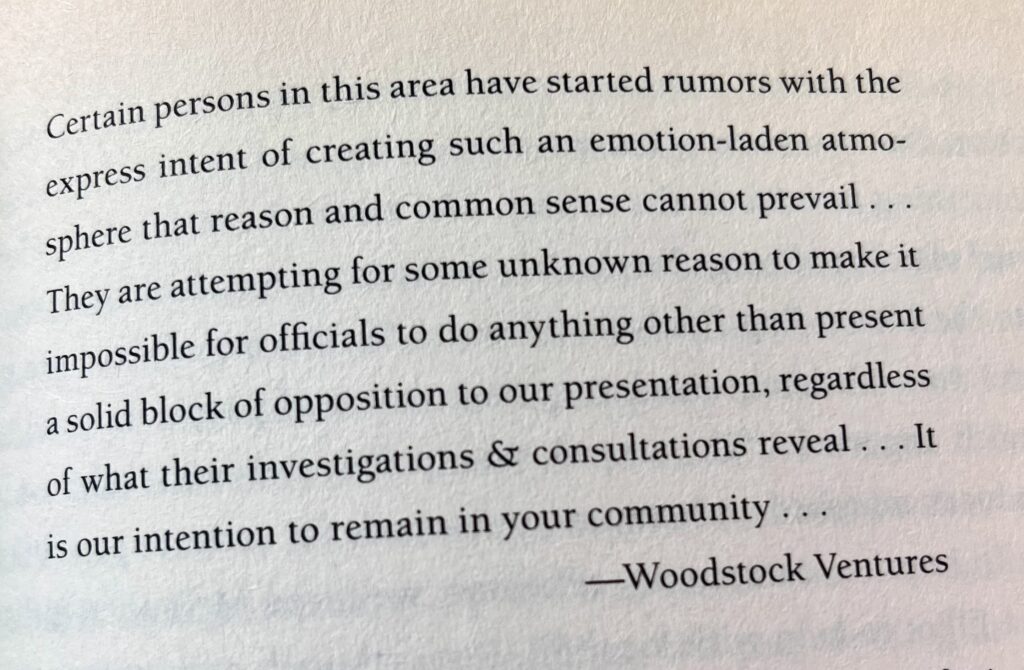 July 2: town meeting in Wallkill with many voicing highly critical views of festival. After the public meeting the council passed an ordinance severely curtailing public events. Woodstock Ventures would have an opportunity at a later meeting to show compliance with the various parts of the ordinance.
July 2: town meeting in Wallkill with many voicing highly critical views of festival. After the public meeting the council passed an ordinance severely curtailing public events. Woodstock Ventures would have an opportunity at a later meeting to show compliance with the various parts of the ordinance.
July 4 – 5: Atlanta International Pop Festival at the Atlanta International Raceway, Hampton, GA was a success, but a NYT article stated that the event presented “an impromptu but efficient commodities exchange in marijuana and LSD, where buyers and sellers let supply and demand establish prices.”
Such news only added to the Wallkill residents’ aggressive confrontation of the Woodstock Festival.
July 5: John Fabbri and Don Ganoung met with transportation representatives from All-State Bus Corporation to discuss transportation for festival attendees. Fabbri and Ganoung also met with NYCPD Chief Inspector McManus to help mobilize the Peace Service Corps.
July 6: more bad media news: The NYT reported, “The Newport Jazz Festival was invaded…by several hundred young people who broke down a section of the 10-foot wooden fence surrounding Festival Field and engaged in a rock throwing battle with security guards.” (see July 7)
July 7: in Albany, Wes Pomeroy and Don Ganoung met with Harrison F Dunbrook, the director of traffic operations for the NY State Dept of Transportation. Pomeroy and Ganoung hoped to get permission for highway alterations during the festival weekend. Their request was denied.
Signage for the festival along Rt 17 would be permitted provided Woodstock Ventures went through the normal approval process. Permission to use a nearby completed but unused section of Interstate 84 was denied.
July 8: the Middletown Fire Department unanimously turned down a proposal to supply personnel to run Nathan’s food concessions. The fire companies’ membership objected to the long hours Nathan had required.
July 8: Wes Pomeroy and Don Ganoung met with town fire advisory board to discuss the festival’s fire protection needs. Instead of evaluating the festival’s requirements and coming to an informal arrangement, the advisory board decided not to act on the proposed plans until it was asked to do so by the town board under the new local law.
Chronology Woodstock Music Art Fair
Another Wallkill!
July 8: Joel Rosenman received a letter from Margaret Y Tremper, the deputy town clerk from the Town of Shawangunk in upstate NY. The letter informed the festival organizers that the festival address used on advertising was misleading as Wallkill, NY (Ulster County) was not the same as the Town of Wallkill (Orange county), where the festival was. She hoped that they would correct their advertising to avoid having thousands of attendees mistakenly arriving at her location and not theirs.
Chronology Woodstock Music Art Fair
More negative festival news
July 8: a Smoky Robinson and the Miracles concert in Boston resulted in scattered incidents of stone throwing and window breaking after the sound system has problems. (see July 8)
July 8: Miles Lourie resigned as counsel for Woodstock Ventures because of the recent appointment of Peter Marshall as an additional counsel.
Second week of July: Peter Goodrich continued to try to find companies for the festival’s food concession stands.
July 10: Peter Goodrich and John Roberts met in Peter Marshall’s office with Charles Baxter, Jeffrey Joerger, and Lee Howard of Food for Love.
Because of the lack of any other companies offering their services and the late date, Roberts approved Food for Love’s application.
July 10: the entire production staff met to go over all progress that had been made since they began. Most were pleased with the many tasks accomplished and plans in place.
July 11: Acting State Supreme Court Justice Edwin M O’Gorman, after hearing remarks from both sides of the dispute, reserved his decision for an injunction against Woodstock Ventures since no festival application had been applied for (based on the new ordinance of July 2) and therefore no permit given.
July 13: Ulster County assemblyman Clark Bell, a Republican from Woodstock, released a statement to the press about a letter he’d just sent to Governor Rockefeller requesting the appointment of a coordinator to oversee the festival. He also recommended that the National Guard be alerted.
July 14: THE meeting. Woodstock Ventures presented its application for the festival’s approval based on the new ordinance. The meeting lasted until 1 AM.
Chronology Woodstock Music Art Fair
Eviction
July 15: in a closed session at the town hall, the Wallkill Zoning Board of Appeals passed judgment on the status of Woodstock Venture’s application for a permit. The five-member board refused to allow the festival to build anything on the 200-acre site.
July 16: an eviction notice posted on the front door of Howard Mill’s barn telling Woodstock Ventures to vacate the premises. To this point approximately 150,000 tickets had been sold and $500,000 spent on the concert.
Chronology Woodstock Music Art Fair
The third W: White Lake
July 16: while they were gone, Elliott Tieber contacted them about a place in Bethel, NY.
Tieber’s parents ran the El Monaco Motel at the intersection of Rts 17B and 55. His site was completely unsuitable. Tieber (may or may not have) contacted Morris Abraham who set up meeting with Max Yasgur.
I had originally written that on the same date “Mel Lawrence and Michael Lang helicopter over area looking for new location for concert. ”
From Ticia Agri, Lang’s assistant: “Ticia Agri No one helicoptered up. Michael and I drove up after Eliot Tiber called me to offer his property We got up and saw his property was a swamp and Michael and I drove around looking for a sight as Eliot already had a permit in place with the town. We came upon Happy Ave and I said “ Michael we have to choose a road of that name. Let’s turn on Happy Ave we are coming from Wallkill!!!” So we took it and it turned into Hurd Ave and there in front of us was Yasgur’s farm. Elated we went back to the El Monaco to wait for Mel to arrive. We found out whose farm it belonged to from Eliot and when Mel arrived He and Michael went to find Max Yasgur and make a hand shake deal. We all moved into the El Monaco motel and went to work.
Chronology Woodstock Music Art Fair
Hero Max Yasgur
July 17: although initially expressing disinterest in renting land for the festival, Max Yasgur agreed to meet with Woodstock Ventures after hearing that it is the group just kicked out of Wallkill.
July 18: in the morning, Michael Lang and Ticia Bernuth explored Bethel area. Happy Road appears and they follow it where they soon “discover” the site.
In the afternoon Lang, Mel Lawrence, Elliot Tieber, and Morris Abraham met with Yasgur. The property he initially offered (across from his home?) was far too flat.
Yasgur offered another site which turned out to be the same spot Lang and Bernuth had seen that morning.
July 19: John Roberts and Michael Lang discuss finances. Roberts concerned about additional costs.
Chronology Woodstock Music Art Fair
Bethel Blow-back
July 20: someone nailed a sign “Stop Max’s Hippy Music Festival” to tree at driveway entrance. The sign angered Yasgur and convinced him his decision to allow concert on his property was the right one.
July 21: Judge Edward O’Gorman handed down decision banning the festival from the Wallkill site.
Max Yasgur spoke at a Bethel Town meeting expressing support for the festival. He said, “ “I hear you are considering changing the zoning law to prevent the festival. I hear you don’t like the look of the kids who are working at the site. I hear you don’t like their lifestyle. I hear you don’t like they are against the war and that they say so very loudly. . . I don’t particularly like the looks of some of those kids either. I don’t particularly like their lifestyle, especially the drugs and free love. And I don’t like what some of them are saying about our government. However, if I know my American history, tens of thousands of Americans in uniform gave their lives in war after war just so those kids would have the freedom to do exactly what they are doing. That’s what this country is all about and I am not going to let you throw them out of our town just because you don’t like their dress or their hair or the way they live or what they believe. This is America and they are going to have their festival.”
The Bethel council unanimously approved Woodstock Ventures request to hold the event.
July 22: Mel Lawrence brought festival workers from Wallkill to Bethel. He held a general meeting at El Monaco Motel.
Around this time, Woodstock Ventures, seeing the Earth Light Theatre on the El Monaco site, asked the the troupe would do performances at the festival. They agreed
Allan Mann, of Earth Light, offered to arrange for Sri Swami Satchidananda to open the festival on Friday 15 August.
July 24: Bethel Supervisor reported that he’d received about twenty phone calls from residents opposed to festival, but no legal threats.
July 25 – 26 (?): screening process of police who wanted to work festival. Those approved told to report to site on August 14.
July 26: a committee of Bethel residents began circulating petition that opposed festival.
July 28: a benefit was held at the Village Gate (NYC) to raise money for scholarship funds to enable young artists to exhibit at Woodstock. Performers at the benefit included Marian McPartland, Les McCann, and Robert Flack.
Chronology Woodstock Music Art Fair
Bethel businesses say “Yes”
July 28: town meeting for presentation of the all-inclusive draft of festival to NY State Health Department lasted 8-hours as many residents challenged each part of presentation, but all questions were answered.
That night the Bethel Businessman’s Association voted to support festival.
July 29: Woodstock Ventures served with papers to appear in court regarding impact of festival on local summer youth camps and local homeowners. An out-of-court settlement agreed to with camps. Judge George Cobb stated that he’d hand down his decision on August 14—the day before the festival was to begin.
Renewed preparations hectic
The abandoned Diamond Horseshoe hotel ready for workers to move in.
July 30: Max Yasgur gave permission to Woodstock Ventures to drill on festival site for water.
Lang, Kornfeld, Roberts, and Rosenman met to discuss how to publicize the festival’s new location. Arnold Skolnick’s drawing.
August 2, 1969: Town of Bethel Building Inspector Donald Clark sent letter to Woodstock Ventures stating that he has lifted the Stop Order against it and that all permits would be issued pending approval by the departments of health and agriculture.
Chronology Woodstock Music Art Fair
Filming decision
August 3: from Dale Bell’s book Woodstock (quoting John Roberts): “Over the course of the spring and summer we had gone to several meetings with filmmakers like Pennebaker and the Maysles Brothers, and they had all expressed interest in making our movie. But talks had languished and then died when it became clear that we would have to finance their efforts ourselves. Bob Maurice and Mike Wadleigh had been latecomers to this process. I had seen some of Wadleigh’s work and thought it to be original and clever, but noting I had seen altered my fundamental view that financing a documentary was a sane use of my vanishing resources.
Sunday, August 3rd, 1969 was turning into another typical day at the office. …Around noon I decided to take a break and go someplace where the phones wouldn’t ring with Woodstock problems. I walked down to my dad’s apartment in midtown. …The phone rang. It was Bob Maurice. …I said “What’s on your mind?” “About 90 grand,” he said. “That’s what it will take for you to own this movie.” I lectured him patiently on the economics of documentaries, concluding with a polite but firm refusal. “You’ll have to get it somewhere else, Bob, I’m pretty much tapped.
Chronology Woodstock Music Art Fair
“…a week later…”
August 4: Don Ganoung presented the Bethel Medical Center with a check for $10,000; officers of the Peace Service Corps moved into their headquarters on Lake Street.
August 7: chartered Hog Farm flight from Santa Fe arrived at JFK Airport with 85 members who join other Hog Farm members who’d already arrived. The flight also included 15 Hopi artists.
Total festival workforce exceeded 1,500.
Chronology Woodstock Music Art Fair
Sunday 10 August 1969
- Chris Langhart assisted by a corps of technical people he knew from summer theatres in Syracuse, began constructing a footbridge over the increasingly congested West Shore Road.
- Howard Hirsch and Peter Leeds begin setting up the exhibition of amateur artists along the festival’s northwestern perimeter.
- stage construction progressed to the point where builders were ready to put the deck on top.
- (around this date) from Dale Bell’s book Woodstock (John Roberts speaking): … one of my partners (Artie Kornfeld?) made a deal with Warner Brothers for the $90,000. When the smoke cleared they owned 90% of everything, and we got 10% of the profits from the film and about one-half of 1% of the albums. Even those drastically reduced percentages were enough to bail us out of debt when the show lost $1,600,000, and 10 years later we could count ourselves slightly in the black.
Chronology Woodstock Music Art Fair
Monday 11 August 1969
- John Roberts packed for trip to Bethel. As of that afternoon’s accounting, Woodstock Ventures had posted receipt of advance ticket sales totaling $1,107,936. Woodstock Ventures (John Roberts) had spent nearly twice that sum.
- telephone poles bolted into place around stage, but it is discovered that many are split or rotten.
- Woodstock Ventures came to agreement with William Filippini for use of Filippini Pond for $5,000.
Chronology Woodstock Music Art Fair
Tuesday 12 August 1969
- festival representatives meet with the state supreme court justice regarding complaints by local businesses about the festival’s impact on them. After reassurances and explanations all complaints were dropped.
- the Food For Love concession area remained unfinished.
Chronology Woodstock Music Art Fair
Wednesday 13 August 1969
- early 30,000 people had already shown up for festival and are in the “bowl.” Bill Hanley pulled his sound truck into the service road behind the stage, plugged in some equipment to a portable amplifier and piped prerecorded music for the appreciative crowd.
- staff technicians notice drop in water pressure throughout site. Audience members had accidentally stepped on and cracked plastic pipes. Repairs made.
- John Roberts with his father and brother, arrived on site to discover that there are no ticket booths for the 30,000 people already on-site.
- the suit against the festival withdrawn after a promise of police protection for the residents was agreed to.
- it is discovered that the $200 an hour crane is trapped within its own construction of the pedestrian bridge over West Shore Road.
- NYC Police Commissioner Howard Leary reminded all NYC police officers that “moonlighting” was strictly prohibited.
- NY State Police “randomly” stop and frisk young people in cars at Harriman interchange on NY State Thruway. Drivers, passengers, and cars were checked for anything illegal.
Chronology Woodstock Music Art Fair
Thursday 14 August 1969
- State Police continue to randomly stop and frisk young drivers at Harriman interchange. 150 arrests made.
- Bill Handley’s sound system erected. “According to one expert’s cumulative eye, the hi-fi equipment in the bowl represented the most expensive sound system ever assembled at one time in any given location.”
- Bill Abruzzi, doctor hired to take care of medical issues at the festival, told festival to triple his supply order.
- although warned not to, about 270 NYC police show up but insist on being paid in cash without receipts. They work using aliases and were paid more than the agreed amount.
- Food For Love demanded all profits after repaying the initial $75,00 fee. Woodstock Ventures agreed.
- film deal reached: 50% split. Warner Brothers and Woodstock Ventures after negative costs. On Friday, Michael Wadleigh signed on as director.
- the Diamond Horseshoe, where nearly 200 Woodstock staff had been staying, caught fire. The fire was extinguished by hotel staff because the fire department couldn’t get through.
- about 5 pm Charlie Maloney left Queens N.Y. for White Lake. His attendance at the event would change his life.
Chronology Woodstock Music Art Fair
Declined invitations and missed connections
Take with an extra extra grain of salt, but for what it’s worth, From The College of Rock and Roll:
- Bob Dylan: although in his “backyard,” Dylan was never in serious negotiation to play. In mid-July, Dylan had signed to play the Isle of Wight Festival of Music, on August 31. Dylan set sail for England on Queen Elizabeth 2 on August 15, the day the Woodstock Festival started. His son was injured by a cabin door and the family disembarked. Dylan, with his wife Sara, flew to England the following week. Dylan had been unhappy about the number of hippies piling up outside his house in the nearby town of Woodstock.
- The Beatles after live performances: The Beatles/John Lennon: There are two scenarios as to why The Beatles did not perform. The first is that promoters contacted John Lennon to discuss a Beatles performance at Woodstock, and Lennon said that the Beatles would not play unless there was also a spot at the festival for Yoko Ono’s Plastic Ono Band, whereupon he was turned down. The more likely explanation is that Lennon wanted to play but his entry into the United States from Canada was blocked by President Richard Nixon. The Beatles were, in any case, on the verge of disbanding. Also, they had not performed any live concerts since August 1966, three full years before the festival (not including their impromptu rooftop concert given on January 30, 1969 a few months before).
- The Jeff Beck Group: Jeff Beck disbanded the group prior to Woodstock. “I deliberately broke the group up before Woodstock”, Beck said. “I didn’t want it to be preserved.
- The Doors were considered as a potential performing band but canceled at the last moment. According to guitarist Robby Krieger, they turned it down because they thought it would be a “second class repeat of Monterey Pop Festival” and later regretted that decision.
- Led Zeppelin was asked to perform, their manager Peter Grant stated: “We were asked to do Woodstock and Atlantic were very keen, and so was our U.S. promoter, Frank Barsalona. I said no because at Woodstock we’d have just been another band on the bill.” However, the group did play the first Atlanta International Pop Festival on July 5, as one of 22 bands at the two-day event. Woodstock weekend, Zeppelin performed south of the festival at the Asbury Park Convention Hall in New Jersey.
- The Byrds were invited, but chose not to participate, figuring Woodstock to be no different from any of the other music festivals that summer. There were also concerns about money. As bassist John York remembers: “We were flying to a gig and Roger [McGuinn] came up to us and said that a guy was putting on a festival in upstate New York. But at that point they weren’t paying all of the bands. He asked us if we wanted to do it and we said, ‘No’. We had no idea what it was going to be. We were burned out and tired of the festival scene. So all of us said, ‘No, we want a rest’ and missed the best festival of all.”
- Chicago, at the time still known as the Chicago Transit Authority, had initially been signed on to play at Woodstock. However, they had a contract with concert promoter Bill Graham, which allowed him to move Chicago’s concerts at the Fillmore West. He rescheduled some of their dates to August 17, thus forcing the band to back out of the concert. Graham did so to ensure that Santana, which he managed at the time, would take their slot at the festival. According to singer and bassist Peter Cetera, “We were sort of peeved at him for pulling that one.”
- Tommy James and the Shondells declined an invitation. Lead singer Tommy James stated later: “We could have just kicked ourselves. We were in Hawaii, and my secretary called and said, ‘Yeah, listen, there’s this pig farmer in upstate New York that wants you to play in his field.’ That’s how it was put to me. So we passed, and we realized what we’d missed a couple of days later.”
- The Moody Blues were included on the original Wallkill poster as performers, but decided to back out after being booked in Paris the same weekend.
- Frank Zappa and the Mothers of Invention, according to the Class of the 20th Century U.S. television special, is quoted as saying “A lot of mud at Woodstock … We were invited to play there, we turned it down.’
- Arthur Lee and Love declined the invitation, but Mojo Magazine later described inner turmoil within the band which caused their absence at the Woodstock festival.
- Free was asked to perform and declined.
- Spirit also declined an invitation to play, as they already had shows planned and wanted to play those instead, not knowing how big Woodstock would be.
- Joni Mitchell was originally slated to perform, but canceled at the urging of her manager to avoid missing a scheduled appearance on The Dick Cavett Show.
- Lighthouse declined to perform at Woodstock.
- Roy Rogers was asked by Michael Lang to close the festival with Happy Trails but he declined.
- Procol Harum was invited but refused because Woodstock fell at the end of a long tour and also coincided with the due date of guitarist Robin Trower’s baby.
- Jethro Tull also declined. According to frontman Ian Anderson, he knew it would be a big event but he did not want to go because he did not like hippies and other concerns including inappropriate nudity and the money being right.
- Iron Butterfly was billed for Sunday on the poster circa Walkill, but could not perform because they were stuck at an airport.
Chronology Woodstock Music Art Fair
Chronology Woodstock Music Art Fair
Epilogue
August 23: the New York Times reported that, “Max Yasgur, whose 600-acre dairy farm was the site of the music festival that drew hundreds of thousands of young people to Sullivan County last weekend, said yesterday that he had “no thoughts of renting my farm” for a 1970 version of the gathering as reported by the festival’s producers.”
September 9: The New York Times reported the likely breakup of the Woodstock Ventures partners. Michael Lang and Artie Kornfeld agree to a buyout of $31,750 each.
January 7, 1970: a neighbor of Max Yasgur sued him for $35,000 for property damage caused by the festival.
March 26, 1970: Warner Brothers released the film documentary, Woodstock. Michael Wadleigh was the director. It received the Academy Award for Best Documentary Feature. Thelma Schoonmaker was nominated for the Academy Award for Film Editing, a rare distinction for a documentary. Dan Wallin and L. A. Johnson were nominated for the Academy Award for Best Sound.
May 11, 1970: release of the triple soundtrack album ‘Woodstock’ in the US, going gold within two weeks.
February 9, 1973: Max Yasgur died at age 53. His New York Times obituary described Yasgur as “just another dairy farmer in Sullivan County” before the Woodstock Music and Art Fair.
December 4, 1977: Max and Miriam Yasgur’s daughter Lois Yasgur Elston died in a car accident. [Find a Grave article]
10 Year Reunions
Long Island, NY
Saturday 8 September 1979: Woodstock Reunion concert held at Parr Meadows racetrack in the town of Brookhaven, New York. It had a reported audience of about 18,000 – 40,000 by concert promoter Richard Nader.
Performers included Paul Butterfield and Rick Danko, Canned Heat, Richie Havens, Jorma Kaukonen, Country Joe McDonald, John Sebastian, Michael Shrieve, Stephen Stills, Leslie West, and Johnny Winter
Madison Square Garden
August 24 and 25, 1979: Woodstock ’79 was took place at the Felt Forum at Madison Square Garden, New York City.
The word “Woodstock” did not appear in the advertisement for the event, it was simply billed as “Celebration: Ten Years Later.”
Some of the musicians performed at the original festival of 1969. There were jam sessions with Richie Havens, Taj Mahal, Alhaji Bai Konte, Dembo Konte, Country Joe and the Fish, Canned Heat, Jeff “Skunk” Baxter and Elliott Randall. Also appearing were Rick Danko, Jorma Kaukonen, Stephen Stills, Paul Butterfield, and Johnny Winter among others.
Chronology Woodstock Music Art Fair
Wayne Saward
In 1984, Wayne Saward made a concrete monument dedicated to the Woodstock Music and Art Fair. He set the monument at the corner of the festival’s original field.
December 1, 1986: Miriam Yasgur sold farm to Roy Howard.
20 Year Spontaneous Reunion
Woodstock ’89
August 15, 16, & 17 1989: Woodstock ’89 or “The Forgotten Woodstock” took place on the site of the original Woodstock as a spontaneous celebration of the event’s 20th anniversary.
The event began with a single folk guitarist, Rich Pell, who came to the site. Charles and June Gelish, who owned the property, gave permission to Pell to organize the show by.
With the help of Will Hoppey, Pell organized all aspects of the concert from ordering water trucks to working out who would perform on the stage. Rich also emceed the festival.
The whole event was spontaneous. Anyone was invited to perform regardless of skill levels, and the majority of performers were lesser-known bands. Wavy Gravy, the Woodstock All-Stars, and Al Hendrix, the father of Jimi Hendrix, appeared at the concert.
Wayne Thiel played a small set of Hendrix material shortly before Al Hendrix came onto the stage. The band was called “Head First”.
Jimi’s Guitar
April 25, 1990: the Fender Stratocaster that Jimi Hendrix played at the Woodstock festival was auctioned off for a record $295,000.
Woodstock ’94
August 12, 13, & 14, 1994: Woodstock ’94 commemorated the 25th anniversary of Woodstock. It was promoted as “2 More Days of Peace and Music”. The poster used to promote the first concert was revised to feature two doves perched on the neck of an electric guitar, instead of the original acoustic one.
The 1994 concert was scheduled for the weekend of August 13–14, with a third day (Friday, August 12) added later. Tickets to the festival cost $135 each. The weather was hot and dry on Friday but by early Saturday afternoon the storms rolled in. The rains turned much of the field into mud.
The event took place on Winston Farm, just west of Saugerties, New York
Chronology Woodstock Music Art Fair
Bethel Woods Center for the Arts
Following the sale of Cablevision Industries to Time Warner in 1996, Allen Gerry created the Gerry Foundation, a not-for-profit organization established to improve the quality of life and revitalize the economy in his native Sullivan County. ,
Among the Foundation’s project, it acquired the 37-acre field that was the site of the original Woodstock festival, along with hundreds of surrounding acres, and explored the idea of creating a world-class performing arts center.
On May 4, 1998 Wes Pomeroy died. His New York Times obituary described Pomeroy as, “a law enforcement officer who viewed protesters as citizens, not criminals, and whose approach to crowd control was to coddle, even if it meant sharing police communications systems with a rally’s organizers and teaching angry counter-protesters how to set up picket lines.”
A Day In The Garden…1998
August 14, 15, and 16, 1998: the Gerry Foundation produced the three-day “Day in the Garden” festival at the same site.
The three-day event featured Woodstock legacy acts Pete Townshend, Richie Havens, and Melanie along with Donovan, Goo Goo Dolls, Third Eye Blind, Stevie Nicks, Joan Osborne and Lou Reed. Highlights included Pete Townshend reviving “See Me, Feel Me” as the sun went down and Stevie Nicks playing an epic rendition of “Edge of Seventeen.”
The most impressive booking was Joni Mitchell, who toured very infrequently throughout the 1980s and 1990s and would essentially retire from the road in 2000. [Rolling Stone article]
Woodstock 1999
July 22–25, 1999: Woodstock ’99 (also called Woodstock 1999), held was the second large-scale music festival (after Woodstock ’94) that attempted to emulate the original Woodstock festival of 1969.
It was held in Rome, New York and the attendance was approximately 400,000 over four days.
Oppressive heat, an air base setting (much tarmac), and the 1.5 mile distance between the two stages made conditions particularly difficult for attendees.
Those conditions and questionable judgement on the part of some performers who encouraged poor behavior resulted in violence, vandalism, and sexual assaults. [RNZ article]
John Roberts Dies
October 27, 2001: John Roberts, aged 56, died. His New York Times obituary described him as. “a businessman who nevertheless pursued fun before profit.”
In 2002, the Foundation hired architectural firm Westlake Reed Leskoskyto plan and design Bethel Woods Center for the Arts.
2004: the foundation selected Suffolk Construction as general contractor
2004: ground broke on the $150 million multi-venue project . In recognition of its historical legacy and in keeping with its core values and beautiful surroundings, the design and construction of Bethel Woods was completed using local and regional materials and renewable resources to the greatest extent possible.
The Pavilion amphitheater at Bethel Woods opened to the public on July 4, 2006 with a performance by the New York Philharmonic.
June 2008: the Museum opened
March 23, 2009: Wayne Saward, designer of the Woodstock monument, died. His obituary said in part, “He always dreamed of putting a monument up there. It was his dream and he never looked to make any money off of it.”
2012, Bethel Woods transitioned from a project of the Gerry Foundation to its own 501(c) (3) public charity governed by an independent board of trustees with Mr. Gerry serving as the Chairman of the Board.
September 16, 2014: Miriam Yasgur died. [Obit]
June 23, 2016: Max and Miriam’s son “Sam” Stephen Yasgur died in Charles County, Maryland. [Legacy obituary]
August 3, 2016: Elliot Tiber died in Boca Raton, Fla. from complications of a stroke. Tiber had helped introduce Woodstock Ventures to the Bethel area when he found out that Wallkill had kicked out the festival. (NYT obituary)
In June 2017, the site was added to the National Register of Historic Places. [NPR story]
July 8, 2017: Howard Mills died. His obituary had no reference to his part in the Woodstock Music and Art Fair.
January 8, 2022: Michael Lang died at Sloan Kettering hospital in New York. He was 77.
Chronology Woodstock Music Art Fair
Chronology Woodstock Music Art Fair, Chronology Woodstock Music Art Fair, Chronology Woodstock Music Art Fair, Chronology Woodstock Music Art Fair, Chronology Woodstock Music Art Fair, Chronology Woodstock Music Art Fair, Chronology Woodstock Music Art Fair, Chronology Woodstock Music Art Fair, Chronology Woodstock Music Art Fair, Chronology Woodstock Music Art Fair, Chronology Woodstock Music Art Fair, Chronology Woodstock Music Art Fair,
